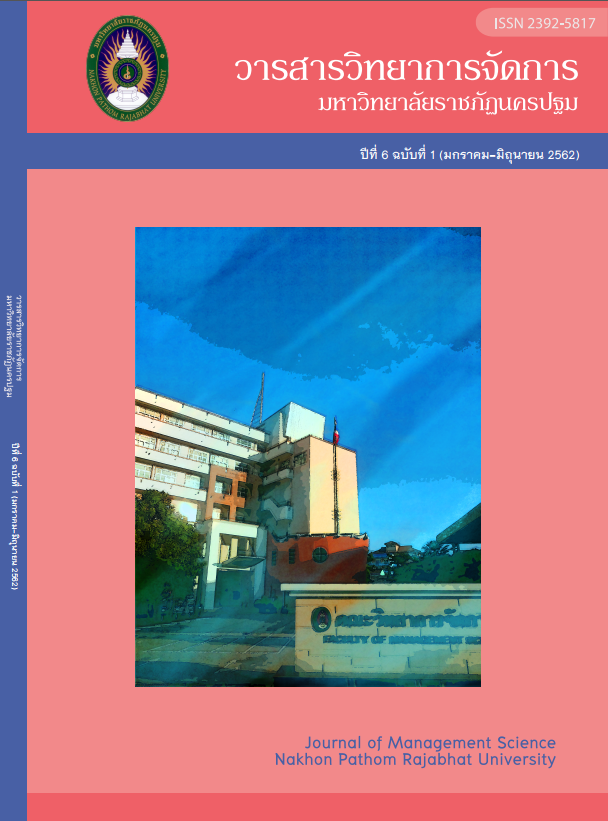Cost and return analysis of investment on oyster mushroom farming in Nakhon Pathom : Case Study Learning resources
Main Article Content
Abstract
The research aim to 1. Study cost and return on investment of oyster mushroom farming in Nakhon Pathom 2. To analyze cost and return on investment of oyster mushroom farming in Nakhon Pathom : Case Study Learning resources. The samples of this study were the entrepreneur of oyster mushroom in Nakhon Pathom province which comprises of Amphoe Muang Nakhon Pathom, Amphoe Kamphaeng Saen, Amphoe Don Toom, Amphoe Nakhon Chaisi, Amphoe Bang Lane, Amphoe Putthamonthon, Amphoe Samphran. The tools used in this research were the interview of oyster mushroom operators in Nakhon Pathom, the analysis of cost and return of investment on oyster mushroom farming in Nakhon Pathom and document analysis by using content analysis.
The results showed that
1. Cost and return of investment on oyster mushroom farming in Nakhon Pathom can be classified as mushroom farming by buying chunk of mushroom to plant and launch mushroom, and mushroom farming by producing chunk of mushroom to plant and launch mushroom.
2. Cost analysis and return by using breakeven analysis which is approximately 584 units of mushroom chunks so could be harvested approximately 234 kilograms of mushroom, at the present wholesale price of mushroom was 50 baht per kilogram. In the cost of 3x4 meters housing which could be placed 1,500 chunks of mushroom with the average housing cost is approximately 7,000 baht. Moreover, one chuck of mushroom could be harvested up to 400 grams in average for 3 months to 3 months and 15 days of mushroom harvesting. The payback period analysis can be found that the total cost could be paid back in the first quarter of chunk mushroom investment, which approximately 2 months and 5 days, and in the next quarter, the net investment especially for mushroom chunks and watering has the average payback period about 1 month and 15 days, at the average price of mushroom chunk was 10 baht.
Article history : Received 10 October 2018
Revised 24 August 2019
Accepted 29 April 2019
SIMILARITY INDEX = 0.98
Article Details
The views and opinions of the article appearing in this journal are those of the author. It is not considered a view and responsibility of the editorial staff.
References
ธานินทร์ ศิลป์จารุ. (2552). การวิจัยและวิเคราะห์ข้อมูลทางสถิติด้วย SPSS. (พิมพ์ครั้งที่ 10). กรุงเทพฯ : บิสซิเนสอาร์แอนด์ดี.
ธารินี พงศ์สุพัฒน์. (2549). การบัญชีทั่วไป General Accounting. (พิมพ์ครั้งที่ 6). กรุงเทพฯ : ห้างหุ้นส่วนจำกัด วีเจ พริ้นติ้ง จำกัด.
พรพรรณ ไชยชุมพล. (2556). ต้นทุนและผลตอบแทนธุรกิจฟาร์มเพาะเห็ดนางฟ้า ในจังหวัดลำปาง. วิทยานิพนธ์ปริญญาบริหารธุรกิจมหาบัณฑิต. มหาวิทยาลัยเนชั่น.
สมนึก เอื้อจิระพงษ์พันธ์. (2550). การบัญชีบริหาร. (พิมพ์ครั้งที่ 3). กรุงเทพฯ : สำนักพิมพ์แมคกรอ-ฮิล.
สำนักงานปลัดกระทรวง กระทรวงศึกษาธิการ. (2542). พระราชบัญญัติการศึกษาแห่งชาติ พ.ศ.2542. กรุงเทพฯ : คุรุสภาลาดพร้าว.
อริสรา ธานีรณานนท์. (2558). การบัญชีเพื่อการจัดการ. นครปฐม : มหาวิทยาลัยราชภัฏนครปฐม
Celik, Y. & Peker, K. (2009). Benefit/cost analysis of mushroom production for diversification of income in developing countries. Bulgarian Journal of Agricultural Science, 15: 228-237.
Factfish, (2013). Mushrooms and truffles, production quantity (tons) - for all countries. Retrieved November 17, 2015, from https://www.factfish.com/statistic/mushrooms%20and%20truffles,%20production%20quantity.
FAO, (2009). High Level Expert Forum - How to Feed the World in 2050. Office of the Director, Agricultural Development Economics Division Economic and Social Development Department
Jaruwan Promngurn. (2015). Cost and Profitability for Mushroom Product. Research Journal of Social Sciences, 8(9), 1-7.
Ram Singh, Bishoi, D.K. & Abhey Singh (2010). Cost Benefit Analysis and Marketing of Mushroom in Haryana. Agricultural Economics Research Review, 23 (1) ,165-171.


